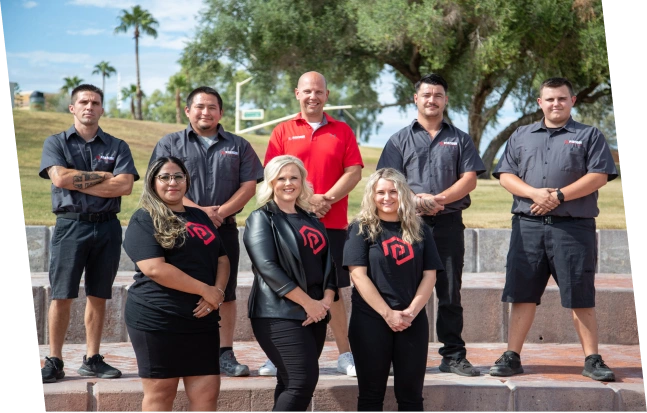Deciding between furnace replacement and furnace repair is a big choice for any homeowner, especially as the temperatures drop. A well-functioning furnace is key to keeping your home warm and safe throughout the colder months, but knowing when to repair versus replace isn’t always straightforward.
While a repair might seem like a more straightforward solution, there are times when replacement is the smarter, more cost-effective option in the long run. Making the right choice helps prevent unexpected breakdowns, helps reduce energy bills, and ensures your home stays comfortable all season.
Here, we’ll explain the factors to consider in this decision so you can confidently choose the best path for your furnace and home.
Age of the furnace
The age of a furnace plays a huge role in deciding whether to repair or replace it. Furnaces have a typical lifespan of about 15 to 20 years. As they age, parts start to wear down, leading to more frequent repairs and potential efficiency issues.
Expected lifespan
If your furnace is nearing or has surpassed the 15-to-20-year mark, it’s likely to become less efficient, even if it still works. Older models weren’t designed to meet today’s efficiency standards, so they usually consume more energy and raise utility costs.
Cost efficiency
For older units, you’ll probably face costly repairs that only patch up an aging system. A general rule is that replacement becomes the smarter investment if a repair costs more than 50% of what a new furnace would cost. Newer furnaces may also have higher efficiency ratings, meaning lower monthly energy bills.
Ultimately, replacing your furnace might save you more money in the long run.
Outdated technology
Older furnaces lack the technological advancements that newer models have, like smart thermostats or advanced efficiency features. These new options make it easier to maintain consistent temperatures and lower energy use.
So, replacement is usually the more economical choice if your furnace is nearing the end of its typical lifespan.

Frequency and cost of repairs
If you notice costly repairs repeatedly happening, you likely have a furnace that’s nearing the end of its life.
Accumulating repair costs
If repair bills start stacking up season after season, these costs quickly add up to the price of a new furnace. The “50% rule” is helpful here — if a single repair costs more than half the price of a new furnace, it’s likely time to consider replacement.
Frequent repairs also signal that the furnace struggles to function correctly, which points to deeper, underlying issues.
Declining performance
Repeated breakdowns often mean critical components, like the blower motor or heat exchanger, are worn down. Replacing these major parts is typically expensive and may not be worth the investment if other parts are likely to fail soon.
A furnace that repeatedly needs service can no longer provide reliable heating, leaving you at risk of a breakdown when you need it most.
Disrupted comfort
Frequent repairs can mean periods of inconsistent or insufficient heat, especially if the furnace breaks down during colder months. A reliable furnace is essential to maintaining consistent comfort in your home.
When you weigh the financial and practical impacts, frequent, costly repairs strongly justify replacing an old furnace. Investing in a new unit that will provide dependable, energy-efficient warmth for years to come is often more economical and reliable.
Energy efficiency
Energy efficiency is key when deciding between furnace replacement and repair because it directly impacts utility costs, environmental impact, and overall comfort.
Older furnaces lack efficiency
Furnaces over 15 years old typically operate at much lower efficiency levels than modern models. This means they use more energy to generate heat, resulting in higher utility bills each month. If your furnace is aging and no longer running efficiently, HVAC services might recommend a replacement to improve energy savings.
Efficiency standards have evolved
In recent years, energy efficiency standards have improved, meaning that newer furnaces are specifically designed to perform better with less energy waste.
High-efficiency models, often with AFUE (Annual Fuel Utilization Efficiency) ratings of 90% or higher, convert most of the fuel they use directly into heat. If your furnace has a lower AFUE rating, investing in a new, efficient model may lead to significant long-term savings on energy bills.
Environmental impact
Running an inefficient furnace costs more and increases your home’s carbon footprint. HVAC services can assess whether a furnace upgrade could make your home more eco-friendly, reducing emissions and energy use through the latest efficiency technology.

Safety and reliability
Safety and reliability are critical when deciding whether to repair or replace your furnace.
Safety concerns with aging furnaces
As furnaces age, they become more prone to serious safety issues, such as carbon monoxide leaks, gas leaks, and electrical malfunctions.
Rusted or cracked heat exchangers, a common issue in older units, can lead to dangerous carbon monoxide emissions, which pose serious health risks.
If there’s any risk of a safety issue, a reliable HVAC service provider will likely recommend replacement over repair to ensure your household’s safety.
Signs of potential safety hazards
Certain warning signs indicate that a furnace may no longer operate safely. These include unusual noises (like banging or rattling), strange odors, soot buildup, and visible rust or corrosion.
While a repair might temporarily fix these problems, they could signal underlying safety issues that will continue to worsen over time. When these red flags appear, replacement is often the safer option.
Minimizing health risks
Inefficient or failing furnaces may lead to poor indoor air quality due to dust, allergens, and potentially harmful gases entering the home. Replacing an old furnace with a new, properly functioning model ensures cleaner air and reduces health risks associated with respiratory irritants.
Safety and reliability are top priorities when choosing between furnace repair and replacement. If your current system poses potential hazards or lacks reliability, a new furnace is a worthwhile investment in your home’s safety, comfort, and health.
Environmental considerations
Environmental considerations are increasingly important when deciding whether to replace or repair your furnace. Here’s how these factors can guide your choice:
Eco-friendly furnace technology
Newer furnaces incorporate advanced eco-friendly technologies, such as variable-speed motors and smart thermostats, which significantly improve energy efficiency.
These technologies adjust energy use based on heating needs, conserving resources and reducing emissions. Replacing an older furnace with one of these models helps you align with eco-conscious goals while enhancing home comfort.
Future energy savings and impact
While an initial replacement investment may seem significant, the energy savings over time contribute to reduced utility bills and minimized environmental impact. High-efficiency furnaces often qualify for energy rebates or incentives, providing economic and ecological benefits that aren’t available with older, less efficient systems.
Reduced waste
A newer, more durable furnace produces less waste over time. An old furnace requiring frequent part replacements or nearing the end of its lifespan will ultimately add to landfills. Opting for a replacement helps minimize waste in the long run, particularly with models built for extended, efficient operation.
Environmental considerations are a powerful motivation for choosing furnace replacement over repair. By consulting HVAC services, you can decide to reduce your carbon footprint, conserve energy, and contribute to a sustainable future.

The value of a professional assessment
When deciding between furnace repair and replacement, a professional assessment is invaluable. HVAC technicians have the experience and expertise to provide a thorough inspection that helps determine the actual condition of your furnace.
While certain signs, like frequent repairs or rising energy bills, can hint at deeper issues, only a trained technician is able to accurately assess internal components, evaluate efficiency, and identify potential safety concerns.
A professional assessment goes beyond basic troubleshooting. Technicians use specialized tools and testing methods to uncover hidden problems that may not be visible to the untrained eye, such as heat exchanger cracks, carbon monoxide leaks, or electrical malfunctions.
An assessment helps you make an informed repair versus replacement decision and ensures your home’s comfort and safety by identifying these issues early.
Call Paragon Service Pros for all your HVAC services
When making the right choice between furnace repair and furnace replacement, trust the expertise of Paragon Service Pros. Our team is here to help you stay comfortable and safe with honest assessments, expert HVAC services, and high-quality solutions tailored to your home’s needs.
Whether you’re dealing with an aging furnace, rising energy bills, or simply want peace of mind, we’re ready to help. Don’t wait until winter hits — call Paragon Service Pros today for all your furnace repair, replacement, and HVAC needs.



